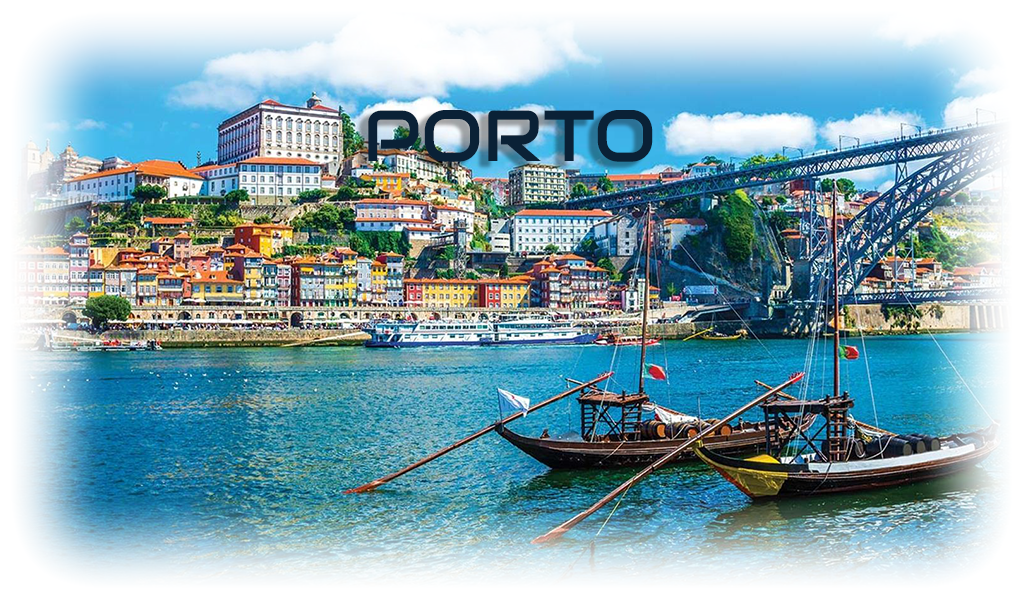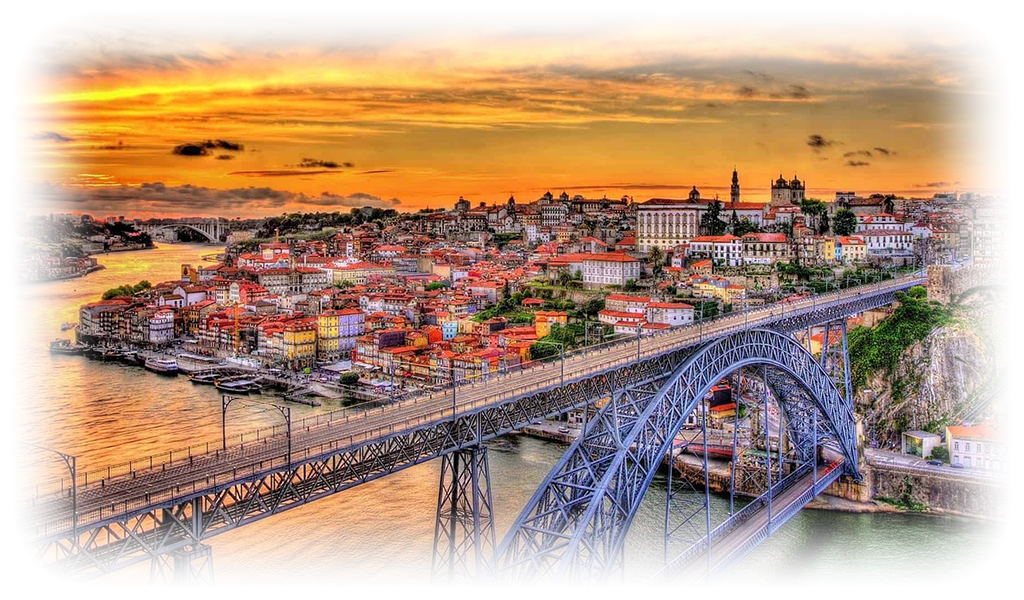
Porto is the second largest city in value and Portugal which affects rich collection of cultural monuments. It is a bustling industrial and commercial center, considered the capital of the Portuguese north. Porto is a picturesque city built along the hills overlooking the mouth of the Douro River, famous for its Baroque architecture, majestic neoclassical buildings and magnificent museums. Its historic heart (Ribeira), a UNESCO World Heritage Site, is a maze of atmospheric narrow streets and stunning architectural treasures.
Geography and weather
Porto is located in northwestern Portugal at the mouth of the Douro River, which flows into the Atlantic Ocean. The city occupies the right bank of the river valley and is built on hills. The distance from Lisbon is 300 kilometers. The climate is subtropical (Mediterranean). The weather here is significantly influenced by the Atlantic, so the summer is usually not as hot as in neighboring Spain . Winter in Porto is warm and quite windy. The temperature, even on the coldest winter nights, rarely drops below zero.
History and interesting facts
Porto is one of the oldest and most significant historical cities in Portugal. It was founded in the 3rd - 4th century BC. BC Celtic tribes. In 136 BC. BC settlement was captured by the Roman Empire. The Romans named the city Portus Cale, from which comes the modern name of the city, the medieval county and the whole country.
After the collapse of the Roman Empire in 540, Porto was conquered by the Visigoths. At the beginning of the 8th century the city was captured by the Moors. In 848 it was recaptured by the founder of the Portuguese county, Vimar Pires, but between 997 and 1050 it was again Moorish. The city was finally liberated in 1092 during the Reconquista era and became part of the kingdom of Leon.
In 1096 the city became part of the county of Portugal, which was later declared an independent state. In 1123, Porto received city status. In 1370, during the reign of Fernando I, the city fortifications were expanded. The city flourished in the 18th century, when the city established close trade relations with England. The main commodity in this trade is port.
In 1809 Porto was occupied by Napoleon's troops. The city was liberated by British troops under the command of the Duke of Wellington. Later, Porto went through fierce military conflicts. Also, the city (like all of Portugal) was actually away from the world wars, which allowed to preserve its historic architecture and atmosphere.
Geography and weather
Porto is located in northwestern Portugal at the mouth of the Douro River, which flows into the Atlantic Ocean. The city occupies the right bank of the river valley and is built on hills. The distance from Lisbon is 300 kilometers. The climate is subtropical (Mediterranean). The weather here is significantly influenced by the Atlantic, so the summer is usually not as hot as in neighboring Spain . Winter in Porto is warm and quite windy. The temperature, even on the coldest winter nights, rarely drops below zero.
History and interesting facts
Porto is one of the oldest and most significant historical cities in Portugal. It was founded in the 3rd - 4th century BC. BC Celtic tribes. In 136 BC. BC settlement was captured by the Roman Empire. The Romans named the city Portus Cale, from which comes the modern name of the city, the medieval county and the whole country.
After the collapse of the Roman Empire in 540, Porto was conquered by the Visigoths. At the beginning of the 8th century the city was captured by the Moors. In 848 it was recaptured by the founder of the Portuguese county, Vimar Pires, but between 997 and 1050 it was again Moorish. The city was finally liberated in 1092 during the Reconquista era and became part of the kingdom of Leon.
In 1096 the city became part of the county of Portugal, which was later declared an independent state. In 1123, Porto received city status. In 1370, during the reign of Fernando I, the city fortifications were expanded. The city flourished in the 18th century, when the city established close trade relations with England. The main commodity in this trade is port.
In 1809 Porto was occupied by Napoleon's troops. The city was liberated by British troops under the command of the Duke of Wellington. Later, Porto went through fierce military conflicts. Also, the city (like all of Portugal) was actually away from the world wars, which allowed to preserve its historic architecture and atmosphere.

How to get there
Porto is one of the most important transport hubs in Portugal. Its airport, located 15 km from the city center, is the third busiest in the country and is considered one of the best in Europe. The airport is connected to the city center by a metro line, providing a quick and easy ride. Ryanair offers low-cost flights to Porto from the following cities: London, Liverpool, Dublin, Marseille, Milan (Bergamo), Paris, Bologna, Rome, Barcelona, Madrid, Valencia, Basel, Geneva, Lyon, Toulouse, Nantes. Porto has rail links to most of Portugal's major cities, as well as Paris and Madrid. The city is also served by five major highways, which allow you to get here quickly by car or bus from Lisbon, Aveiro and Spain.
Food and drinks
Porto is famous for its cuisine. It is considered to be one of the best restaurants in Portugal, most of which are concentrated in Matosinhos(between the beach and the port). The city is also famous for its pastries (bakeries called Pão Quente) and traditional dishes Francesinha (something like a sandwich) and Bacalhau (salted cod).
Attractions
The coastal quarter of Porto or Ribeira is a labyrinth of narrow winding streets and alleys with bright houses of yellow, blue and brown shades, imbued with the aromas of baking and filled with hundreds of voices. This is the most popular area of Porto, which is famous for its lively and friendly atmosphere with many restaurants and grocery stores. The heart of this quarter is the square of the same name, which attracts thousands of people every day. Ribeira is a fascinating history and amazing medieval relics built directly on ancient Roman foundations.
Clerigush is a symbol of Porto and one of the most visible sights of the city. This is a stunning granite tower in the Baroque style, built in the 18th century. To climb to the top you need to overcome 240 steps. These efforts will be rewarded with a panoramic view of the old city and the Douro Valley. The tower is part of a nearby church built between 1732 and 1750. This baroque building is one of the first churches in Portugal to have an elliptical layout.
The Bolshaya Palace is a historic building of a former stock exchange, built in the 19th century on the site of a Franciscan monastery. It is famous for its luxurious interior with Moorish motifs.
The Ascension Port Bridge is a striking example of 20th century engineering thought, opened in 1963. The bridge is built over the Douro River and has a height of 65 meters (at the highest point). An interesting feature of this building is that it can be climbed.
San Francisco is a beautiful 18th-century Baroque church with simply stunning interiors decorated with dazzling gilded elements. Under the church building there are ancient catacombs, which can be visited as part of the tour.
Church of St. Ildefonso is a magnificent 18th century Baroque church with a beautiful façade. This religious building was built on the site of a medieval chapel of the 13th century, which was demolished in the 18th century due to the threat of destruction.
The Louis I Bridge is a grand 19th-century engineering structure that is one of Portugal's most iconic civilian sites. The bridge is built of metal and connects Porto with the city of Vila Nova de Gaia on the opposite bank of the Douro.
The Cathedral (CE) is a significant 12th century church, which is one of the most important Romanesque buildings in Portugal. The construction of the cathedral began in 1110 and was completed only after 627 years.
Karmo Church is a magnificent 18th-century religious building in the Baroque style with a magnificent facade and no less beautiful interior.
Avenida dos Aliados is a wide double avenue and a lively commercial city center with many shops, cafes and restaurants.
Shopping
For shopping, we recommend going to the area of Mercado do Bolhão (here is a grocery market) and Santa Catarina. In the suburbs of Porto are large shopping centers: Norte Shopping, Arrábida Shopping, Parque Nascente, Gaia Shopping and Mar Shopping.
Porto is one of the most important transport hubs in Portugal. Its airport, located 15 km from the city center, is the third busiest in the country and is considered one of the best in Europe. The airport is connected to the city center by a metro line, providing a quick and easy ride. Ryanair offers low-cost flights to Porto from the following cities: London, Liverpool, Dublin, Marseille, Milan (Bergamo), Paris, Bologna, Rome, Barcelona, Madrid, Valencia, Basel, Geneva, Lyon, Toulouse, Nantes. Porto has rail links to most of Portugal's major cities, as well as Paris and Madrid. The city is also served by five major highways, which allow you to get here quickly by car or bus from Lisbon, Aveiro and Spain.
Food and drinks
Porto is famous for its cuisine. It is considered to be one of the best restaurants in Portugal, most of which are concentrated in Matosinhos(between the beach and the port). The city is also famous for its pastries (bakeries called Pão Quente) and traditional dishes Francesinha (something like a sandwich) and Bacalhau (salted cod).
Attractions
The coastal quarter of Porto or Ribeira is a labyrinth of narrow winding streets and alleys with bright houses of yellow, blue and brown shades, imbued with the aromas of baking and filled with hundreds of voices. This is the most popular area of Porto, which is famous for its lively and friendly atmosphere with many restaurants and grocery stores. The heart of this quarter is the square of the same name, which attracts thousands of people every day. Ribeira is a fascinating history and amazing medieval relics built directly on ancient Roman foundations.
Clerigush is a symbol of Porto and one of the most visible sights of the city. This is a stunning granite tower in the Baroque style, built in the 18th century. To climb to the top you need to overcome 240 steps. These efforts will be rewarded with a panoramic view of the old city and the Douro Valley. The tower is part of a nearby church built between 1732 and 1750. This baroque building is one of the first churches in Portugal to have an elliptical layout.
The Bolshaya Palace is a historic building of a former stock exchange, built in the 19th century on the site of a Franciscan monastery. It is famous for its luxurious interior with Moorish motifs.
The Ascension Port Bridge is a striking example of 20th century engineering thought, opened in 1963. The bridge is built over the Douro River and has a height of 65 meters (at the highest point). An interesting feature of this building is that it can be climbed.
San Francisco is a beautiful 18th-century Baroque church with simply stunning interiors decorated with dazzling gilded elements. Under the church building there are ancient catacombs, which can be visited as part of the tour.
Church of St. Ildefonso is a magnificent 18th century Baroque church with a beautiful façade. This religious building was built on the site of a medieval chapel of the 13th century, which was demolished in the 18th century due to the threat of destruction.
The Louis I Bridge is a grand 19th-century engineering structure that is one of Portugal's most iconic civilian sites. The bridge is built of metal and connects Porto with the city of Vila Nova de Gaia on the opposite bank of the Douro.
The Cathedral (CE) is a significant 12th century church, which is one of the most important Romanesque buildings in Portugal. The construction of the cathedral began in 1110 and was completed only after 627 years.
Karmo Church is a magnificent 18th-century religious building in the Baroque style with a magnificent facade and no less beautiful interior.
Avenida dos Aliados is a wide double avenue and a lively commercial city center with many shops, cafes and restaurants.
Shopping
For shopping, we recommend going to the area of Mercado do Bolhão (here is a grocery market) and Santa Catarina. In the suburbs of Porto are large shopping centers: Norte Shopping, Arrábida Shopping, Parque Nascente, Gaia Shopping and Mar Shopping.








